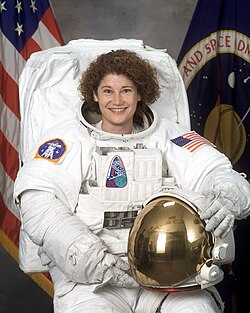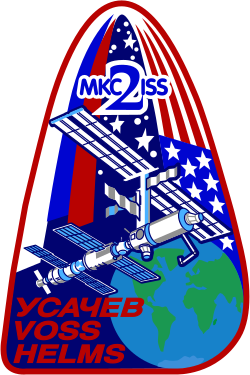Susan Helms
| Susan Helms | |
|---|---|
 | |
| Land | USA |
| Organisation | NASA |
| ausgewählt | 17. Januar 1990 (13. NASA-Gruppe) |
| Einsätze | 5 Raumflüge |
| Start des ersten Raumflugs | 13. Januar 1993 |
| Landung des letzten Raumflugs | 22. August 2001 |
| Zeit im Weltraum | 210d 23h 10m |
| EVA-Einsätze | 1 |
| EVA-Gesamtdauer | 8h 56m |
| ausgeschieden | Juli 2002 |
| Raumflüge | |
Susan Jane „Sue“ Helms (* 26. Februar 1958 in Charlotte, Bundesstaat North Carolina, USA) ist eine ehemalige US-amerikanische Astronautin und Generalleutnant der USAF.
Ausbildung
Helms absolvierte 1976 die Parkrose Senior High School in Portland (Oregon). Sie erhielt 1980 einen Bachelor in Luftfahrttechnik von der United States Air Force Academy. 1985 erwarb sie von der Stanford University einen Master in Raumfahrttechnik.
Astronautentätigkeit
Mit der Raumfähre Endeavour startete Helms als Missionsspezialistin am 13. Januar 1993 zur Mission STS-54. Hauptziele dieser Mission waren das Aussetzen des 200 Millionen Dollar teuren Tracking and Data Relay Satellite (TDRS-F) und Versuche zur Röntgenastronomie mit dem Diffuse X-ray Spectrometer (DXS).
Am 9. September 1994 startete sie mit der Raumfähre Discovery zur Mission STS-64. Während dieser Mission wurde das laseroptische Radarsystems LITE getestet. Eine weitere Aufgabe war das Aussetzen und Bergen des astronomischen Forschungssatelliten SPARTAN-201, einem frei fliegendem Satelliten zur Erforschung des Sonnenwindes und der Sonnenkorona.
Als Missionsspezialistin flog Helms mit der Raumfähre Columbia (STS-78) zu dem bis dahin längsten Flug eines Space Shuttles (16d 21h 48 m). Aufgabe waren Schwerelosigkeitsexperimente im Life and Microgravity Spacelab (LMS), die als Grundlage für zukünftige Experimente auf der Internationalen Raumstation (ISS) benötigt wurden.
Mit der Mission STS-101 wurden ca. 1500 kg Ausrüstungsgegenstände, Hardware und Versorgungsgüter für die geplante erste Stammbesatzung der ISS mit Hilfe des Spacehab und des Integrated Cargo Carrier (ICC) befördert. Helms war Missionsspezialistin für das Rendezvous mit der ISS. Außerdem war sie für die Reparatur des ersten Moduls Sarja der ISS verantwortlich.
Helms arbeitete als Mitglied der ISS-Expedition 2 für 163 Tage auf der ISS. Sie startete mit der Raumfähre Discovery (STS-102) am 8. März 2001 zur Space Station. Die Crew der Expedition 2 installierte und testete den in Kanada gebauten ISS-Roboterarm. Außerdem installierte Helms die mit der Mission STS-104 gebrachte Luftschleuse Quest. Des Weiteren empfing sie bei dieser Mission gemeinsam mit der Sojus-Besatzung den ersten Weltraumtouristen, Dennis Tito. Am 22. August 2001 kehrte Helms mit der Raumfähre Discovery (STS-105) zurück zur Erde.
Am 11. März 2001 stellte sie mit der längsten Außenbordtätigkeit (8 h, 56 m) gemeinsam mit Jim Voss einen Rekord auf.
Nach der NASA
Am 27. Juni 2002 verließ Helms die US-Raumfahrtbehörde und nahm ihren aktiven Dienst in der US-Luftwaffe wieder auf. Sie ging ans Air Force Space Command (AFSPC), das sich auf der Peterson Air Force Base in Colorado befindet. Dort war sie Abteilungsleiterin der Space Control Division. Anschließend kam sie nach Florida und stand bis Februar 2005 dem 45. Space Wing auf der Patrick Air Force Base nahe Cape Canaveral als Vizekommandantin vor. Danach war sie Stellvertreterin für die Pilotenausbildung an der Randolph Air Force Base in Texas. Mit der Beförderung zum Brigadegeneral am 23. Juni 2006 übernahm sie die Leitung des 45. Space Wing und zeichnete für alle Starts von der Cape Canaveral Air Force Station verantwortlich.
Mit ihrer Beförderung zum Generalmajor am 2. August 2009 wechselte Helms zum United States Strategic Command auf der Offutt Air Force Base in Nebraska. Am 21. Januar 2011 wurde sie zum Generalleutnant befördert. Im Jahr 2013 nominierte sie Präsident Obama zur Stellvertretenden Oberkommandierenden des Air Force Space Command. 2014 ging Helms in den Ruhestand. Sie ist damit eine von nur vier Raumfahrern (Helms, Stafford, Chilton, Truly), die in diese Rangklasse der US-Streitkräfte aufstiegen.
In ihrer aktiven Zeit als Testpilotin absolvierte sie Flüge auf mehr als 30 verschiedenen Flugzeugtypen der USAF und der Royal Canadian Air Force.
2020 wurde Helms in die National Academy of Engineering gewählt.
Siehe auch
Weblinks
- Kurzbiografie von Susan Helms bei spacefacts.de
- NASA-Biografie von Susan Helms (englisch; PDF)
- Biografie von Susan Helms in der Encyclopedia Astronautica (englisch)
| Personendaten | |
|---|---|
| NAME | Helms, Susan |
| ALTERNATIVNAMEN | Helms, Susan Jane; Helms, Sue |
| KURZBESCHREIBUNG | US-amerikanische Astronautin |
| GEBURTSDATUM | 26. Februar 1958 |
| GEBURTSORT | Charlotte, North Carolina |
Auf dieser Seite verwendete Medien
The STS-78 patch links past with present to tell the story of its mission and science through a design imbued with the strength and vitality of the 2-dimensional art of North America's northwest coast Indians. Central to the design is the space Shuttle whose bold lines and curves evoke the Indian image for the eagle, a native American symbol of power and prestige as well as the national symbol of the United States. The wings of the Shuttle suggest the wings of the eagle whose feathers, indicative of peace and friendship in Indian tradition, are captured by the U forms, a characteristic feature of Northwest coast Indian art. The nose of the Shuttle is the strong downward curve of the eagle's beak, and the Shuttle's forward windows, the eagle's eyes, represented through the tapered S forms again typical of this Indian art form. The basic black and red atoms orbiting the mission number recall the original NASA emblem while beneath, utilizing Indian ovoid forms, the major mission scientific experiment package LMS (Life and Materials Sciences) housed in the Shuttle's cargo bay is depicted in a manner reminiscent of totem-pole art. This image of a bird poised for flight, so common to Indian art, is counterpointed by an equally familiar Tsimshian Indian symbol, a pulsating sun with long hyperbolic rays, the symbol of life. Within each of these rays are now encased crystals, the products of this mission's 3 major, high-temperature materials processing furnaces. And as the sky in Indian lore is a lovely open country, home of the Sun Chief and accessible to travelers through a hole in the western horizon, so too, space is a vast and beckoning landscape for explorers launched beyond the horizon. Beneath the Tsimshian sun, the colors of the earth limb are appropriately enclosed by a red border representing life to the Northwest coast Indians. The Indian colors of red, navy blue, white, and black pervade the STS-78 path. To the right of the Shuttle-eagle, the constellation Delphinus recalls the dolphin, friend of ancient sailors and, now perhaps too, of the 9 space voyagers suggested by this constellation's blaze of 9 stars. The patch simultaneously celebrates international unity fostered by the Olympic spirit of sports competition at the 1996 Olympic Games in Atlanta, Georgia, U.S.A. Deliberately poised over the city of Atlanta, the Space Shuttle glows at its base with the 5 official Olympic rings in the 5 Olympic colors which can also be found throughout the patch, rings and colors which signify the 5 continents of the earth. This is an international mission and for the first time in NASA patch history, astronauts have dispensed with identifying country flags beneath their names to celebrate the spirit of international unity so characteristic of this flight.
STS-54 Mission Insignia
The STS-101 mission patch commemorates the third Space Shuttle flight supporting the assembly of the International Space Station (ISS). This flight's primary tasks are to outfit the ISS and extend its lifetime, and to conduct a spacewalk to install external components in preparation for the docking of the Russian Service Module, Zvezda, and the arrival of the first ISS crew. The Space Shuttle is depicted in an orbit configuration prior to docking with the ISS. The ISS is depicted in the stage of assembly completed for the STS-101 mission, which consists of the United States-built Unity module and the Russian-built Zarya module. The three large stars represent the third ISS mission in the assembly sequence. The elements and colors of the border reflect the flags of the nations represented by the STS-101 crew members, the United States and Russia. The NASA insignia design for Shuttle flights is reserved for use by the astronauts and for other official use as the NASA Administrator may authorize. Public availability has been approved only in the form of illustrations by the various news media. When and if there is any change in this policy, which is not anticipated, it will be publicly announced.
STS-64 Mission Insignia
Astronaut Susan Jane Helms
The STS-102 crew insignia depicts the International Space Station as it looked when Space Shuttle Discovery was docked. Visible elements include the P6 and Z1 trusses, solar arrays from the Russian segment, 2 Pressurized Mating Adapters, and the Multi Purpose Logistics Module that was temporarily attached to the underside of the Unity Node. The numbers "102" represent the mission tail number. The red, white, and blue ribbons surrounding the space station represent that this is a crew rotation flight. The colors represent the nationalities of the crewmembers (Russian and American). Underneath the ribbons are the flags of the three nations who are the major contributors to the mission (from left to right: Russia, United States, Italy). The names of the 4 permanent crewmembers are displayed in gold around the top of the emblem. Attached to the bottom are six names depicting the six rotating crewmembers (Expedition 2 on top and Expedition 1 on bottom).
ISS Expedition 2 insignia.
The International Space Station Expedition Two patch depicts the Space Station as it appears during the time the second crew will be on board. The Station flying over the Earth represents the overall reason for having a space station: to benefit the world through scientific research and international cooperation in space. The number 2 is for the second expedition and is enclosed in the Cyrillic MKS and Latin ISS which are the respective Russian and English abbreviations for the International Space Station. The United States and Russian flags show the nationalities of the crew indicating the joint nature of the program. When asked about the stars in the background, a crew spokesman said they "...represent the thousands of space workers throughout the ISS partnership who have contributed to the successful construction of our International Space Station."






